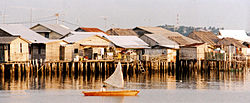Orang loud

The Orang Laut , also known as "Sea People" , are an umbrella term for ethnic groups living in the coastal waters of southeast Sumatra , Batam , southern Johor and the Riau Islands of Indonesia. Because of their way of life in boats, they were among the so-called sea nomads .
Ethnological demarcation
Up until the second half of the 20th century it was assumed that all sea nomads in Southeast Asia had a direct ethno-linguistic connection. However, the new research shows that three main groups with their own cultural and linguistic characteristics can be distinguished:
- The Moken and their related Moklen of the Burmese-Thai Mergui Archipelago ,
- the Orang Laut in the coastal waters of southeast Sumatra , Batam , southern Johor and the Riau Islands of Indonesia,
- the Bajau Laut of the Sulu Archipelago , East Borneo, Sulawesi and the islands of eastern Indonesia.
With the exception of a small overlap among the Moken and Orang Laut, the three groups can be found in different geographical regions.
etymology
The Malay expression Orang Laut means people of the sea . Other well-known names in the Malay language are Lanun , Celates and Orang Selat .
Other names of local groups are Mantong , Barok , Sekah , Rayat and Kuala . One source of misunderstandings in the Malay-speaking area is the general use of the term orang sound for Malay-speaking coastal residents.
history
In history, the orang loudly appear mostly as pirates. However, they also played an important role in the Srivijaya Empire , the Sultanate of Malacca and the Sultanate of Johor . They patrolled the adjoining marine areas and, in turn, provided protection from pirates. They also piloted merchant ships into the ports of their rulers and thus contributed to the dominance of the respective empire.

Eda Green wrote in 1909:
“The Lanuns, supposed to have come from the Philippines, are Mohammedans and are dying out; they were one of the most aggressive tribes in their wild piracy, raiding not only the coasts, but stealing away the children of the Dusuns and Ida'an. "
“The Lanuns probably coming from the Philippines are Mohammedans and are dying out; they are among the most contentious pirate tribes who not only devastated the coasts, but also dragged away the children of the Dusun and Ida'an. "
Subgroups of the Orang Laut
The following subgroups belong to the Orang Laut:
- Duano ; this subgroup is native to East Sumatra
- Urak Lawoi , this subgroup inhabits the islands off the west coast of Thailand from Phuket to the Adang / Rawi island group. Their habitat partially overlaps with that of the Moken.
Culture
Boats of the Orang Laut
The typical boats of the Orang Laut, which were used up to the first half of the 20th century, were remarkably very uniform. They are based on the shape of a canoe, but have an extra plank or two added to increase the freeboard . The boat has a structure made of slotted bamboo aft . At the stern there is a fireplace and the cooking area. The boats are light and extremely maneuverable . The crew always consists of a single family.
fishing
In contrast to the neighboring Malays, the Orang Laut usually fished with spears and harpoons instead of nets and traps. The Duano developed a highly specialized hunting method in brackish water and in mangrove swamps.
literature
- Clifford Sather: The Bajau Laut - Adaption, History, And Fate In A Maritime Fishing Society Of South-Eastern Sabah , Oxford University Press, Kuala Lumpur, 1997, ISBN 983-56-0015-5
- Frank M. LeBar (Ed.): Ethnic Groups of Insular Southeast Asia, Volume 1: Indonesia, Andaman Islands, and Madagascar ; Human Relations Area Files Press, New Haven, 1972
- Frank M. LeBar (Ed.): Ethnic Groups of Insular Southeast Asia, Volume 2: Philippines and Formosa ; Human Relations Area Files Press, New Haven, 1972
Individual evidence
- ↑ a b c Clifford, page 320 ff.
- ^ Clifford, p. 325
- ^ Mary Somers Heidhues: Southeast Asia: A Concise History , p. 27, Hudson and Thames, London, 2000
- ^ Eda Green: Borneo: The Land of River and Palm , Project Canterbury, 1909
- ↑ a b c Clifford, page 327

